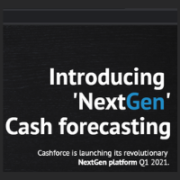The challenges of liquidity planning and forecasting
| 17-06-2019 | treasuryXL | Cashforce |

For more than a decade, liquidity and cash flow forecasting have remained in the top three challenges for CFOs and treasurers globally. This begs the question: why has this been a perennial challenge for so long? The reason: treasury operations today are, for the most part, a series of unintegrated systems, spreadsheets and silos between groups and other departments.
Companies are often faced with multiple ERPs, many entities, and different currencies. These make the task of managing liquidity a major challenge, not to mention a significant manual effort involving many people. The result: lots of time spent gathering and validating data while still not having a full, transparent view into the numbers. The volume, variety, velocity and veracity of data generated each day has made traditional analysis – using spreadsheets, for example – obsolete. It is just not possible to manually aggregate and analyse that much data with sufficient speed to be able to gain insight, and then turn that insight into action. To be able to do so you need the right set of tools.
WHAT SHOULD A TREASURER OR CFO BE ASKING THEMSELVES?
- Can you identify all your sources of data that you need to make a cash flow forecast? Eg ERP (how many do you have, are they all on the same instance), CRM, bank statements, trend analysis, manual data (such as budgets).
- How often do you refresh your short-term/mid-term cash forecast? (Daily, weekly, monthly, quarterly, or I don’t make a cash forecast).
- How do you ensure no mistakes happen in your data capturing/consolidation?
- How do you incentivise your subsidiaries? Local subsidiaries and users typically download information from their ERP, and upload in other types of files to HQ, or in SharePoint, or they will just send Excel files from all over the globe to HQ, which means it’s 100% manual. There’s no real alignment of the processes across subsidiaries and no audit trail at the local level.
WHAT TO CONSIDER?
- Companies should ensure their information is system-based. In other words, they have full integration with their ERP, so they don’t have to manually download data (it should flow automatically).
- Any augmentation of data should have an audit trail so that, ultimately, the group treasurer can see who did what, and when they did it.
- Automate the process and deploy alert functionality, such as reminders for subsidiaries to post their local forecast, and for the group treasurer to look for it.
- Ensure bank connectivity to enable comparison of actuals with forecast figures.
I HAVE THE DATA. NOW WHAT?
With this data, treasurers should now be able to answer these four key questions: what happened; why did it happen; what will happen; and what should be done?
- Descriptive analytics answers the question, “what happened?” This is the most basic form of big data analytics, and provides a picture of past events.
- Diagnostic analytics, “why did it happen?” Diagnostic analytics enables you to perform root cause analysis and use that information to prevent future repetition of events.
- Predictive analytics, “what will happen?” Predictive analytics uses advanced algorithms – often with artificial intelligence and machine learning – to forecast future events.
- Prescriptive analytics, “what should I do?” Prescriptive analytics tells you what the best steps are to achieve a specific result. Prescriptive analytics requires advanced machine learning capabilities.











